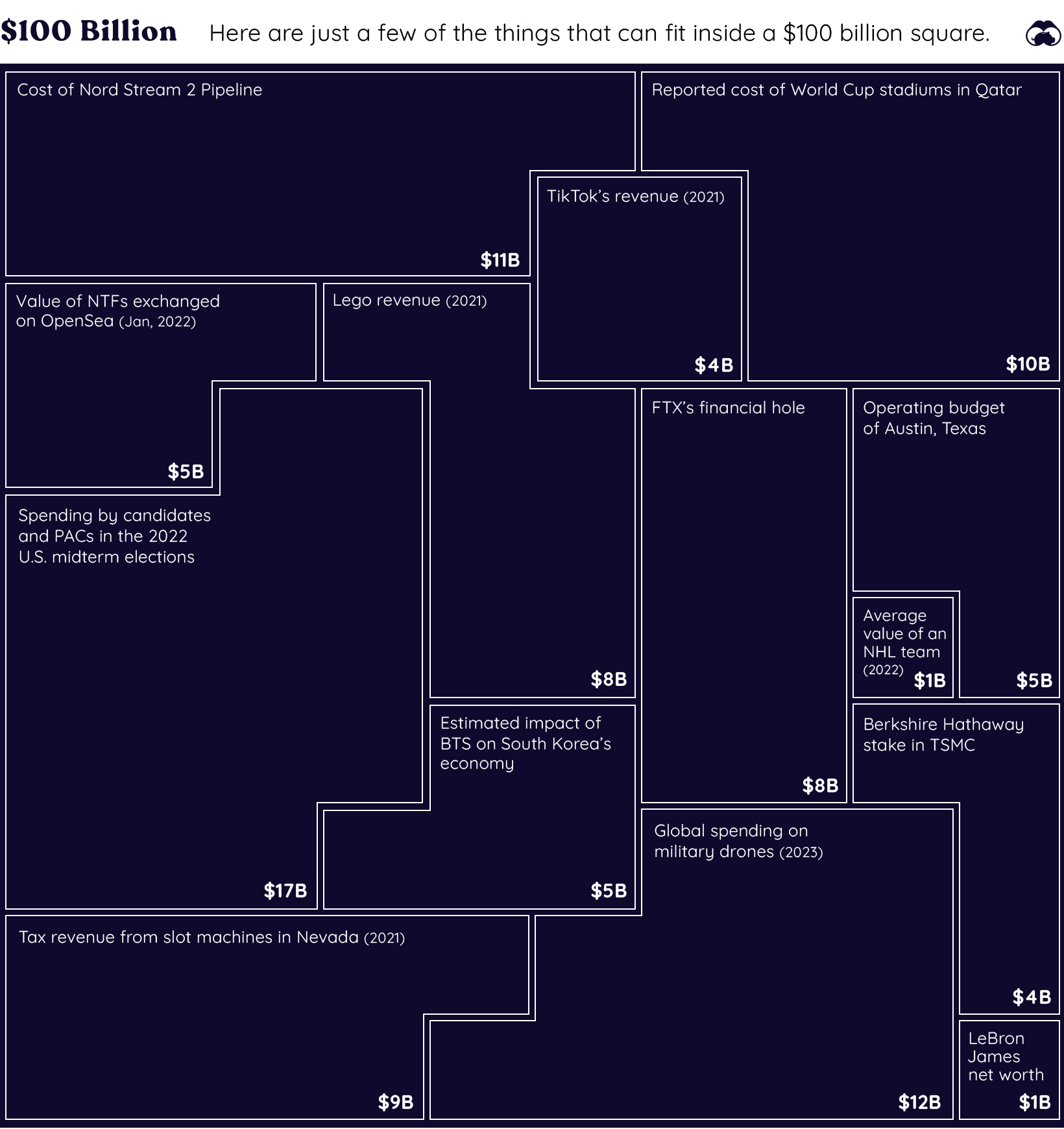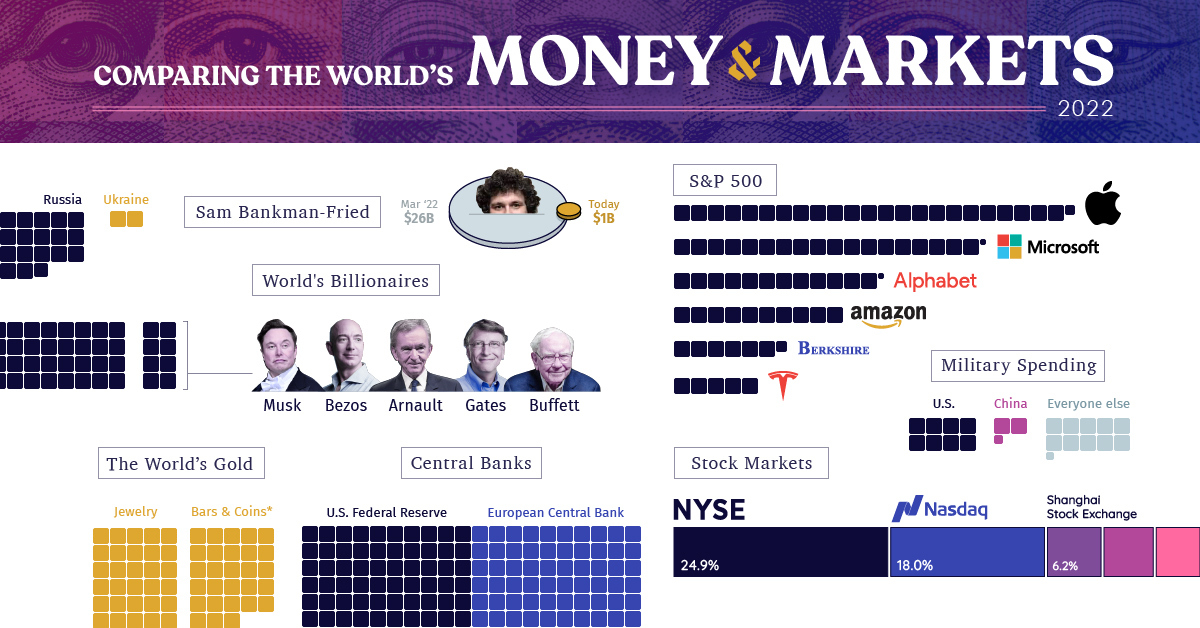All of the World’s Money and Markets in One Visualization (2022)
All of the World’s Money and Markets in One Visualization
The era of easy money is now officially over.
For 15 years, policymakers have tried to stimulate the global economy through money creation, zero interest-rate policies, and more recently, aggressive COVID fiscal stimulus.
With capital at near-zero costs over this stretch, investors started to place more value on cash flows in the distant future. Assets inflated and balance sheets expanded, and money inevitably chased more speculative assets like NFTs, crypto, or unproven venture-backed startups.
But the free money party has since ended, after persistent inflation prompted the sudden reversal of many of these policies. And as Warren Buffett says, it’s only when the tide goes out do you get to see “who’s been swimming naked.”
Measuring Money and Markets in 2022
Every time we publish this visualization, our common unit of measurement is a two-dimensional box with a value of $100 billion.
Even though you need many of these to convey the assets on the balance sheet of the U.S. Federal Reserve, or the private wealth held by the world’s billionaires, it’s quite amazing to think what actually fits within this tiny building block of measurement:

Our little unit of measurement is enough to pay for the construction of the Nord Stream 2 pipeline, while also buying every team in the NHL and digging FTX out of its financial hole several times over.
Here’s an overview of all the items we have listed in this year’s visualization:
Asset categoryValueSourceNotes
SBF (Peak Net Worth)$26 billionBloombergNow sits at <$1B
Pro Sports Teams$340 billionForbesMajor pro teams in North America
Cryptocurrency$760 billionCoinMarketCapPeaked at $2.8T in 2021
Ukraine GDP$130 billionWorld BankComparable to GDP of Mississippi
Russia GDP$1.8 trillionWorld BankThe world’s 11th largest economy
Annual Military Spending$2.1 trillionSIPRI2021 data
Physical currency$8.0 trillionBIS2020 data
Gold$11.5 trillionWorld Gold CouncilThere are 205,238 tonnes of gold in existence
Billionaires$12.7 trillionForbesSum of fortunes of all 2,668 billionaires
Central Bank Assets$28.0 trillionTrading EconomicsFed, BoJ, Bank of China, and Eurozone only
S&P 500$36.0 trillionSlickchartsNov 20, 2022
China GDP$17.7 trillionWorld Bank
U.S. GDP$23.0 trillionWorld Bank
Narrow Money Supply$49.0 trillionTrading EconomicsIncludes US, China, Euro Area, Japan only
Broad Money Supply $82.7 trillionTrading EconomicsIncludes US, China, Euro Area, Japan only
Global Equities$95.9 trillionWFELatest available 2022 data
Global Debt$300.1 trillionIIFQ2 2022
Global Real Estate$326.5 trillionSavills2020 data
Global Private Wealth$463.6 trillionCredit Suisse2022 report
Derivatives (Market)$12.4 trillionBIS
Derivatives (Notional)$600 trillionBIS
Has the Dust Settled Yet?
Through previous editions of our All the World’s Money and Markets visualization, we’ve created snapshots of the world’s assets and markets at different points in time.
For example, in our 2017 edition of this visualization, Apple’s market capitalization was only $807 billion, and all crypto assets combined for $173 billion. The global debt total was at $215 trillion.
Asset2017 edition2022 editionChange (%)
Apple market cap$807 billion$2.3 trillion+185%
Crypto$173 billion$760 billion+339%
Fed Balance Sheet$4.5 trillion$8.7 trillion+93%
Stock Markets$73 trillion$95.9 trillion+31%
Global Debt$215 trillion$300 trillion+40%
And in just five years, Apple nearly quadrupled in size (it peaked at $3 trillion in January 2022), and crypto also expanded into a multi-trillion dollar market until it was brought back to Earth through the 2022 crash and subsequent FTX implosion.
Meanwhile, global debt continues to accumulate—growing by $85 trillion in the five-year period.
With interest rates expected to continue to rise, companies making cost cuts, and policymakers reining in spending and borrowing, today is another unique snapshot in time.
Now that the easy money era is over, where do things go from here?
















![Toni Kroos là ai? [ sự thật về tiểu sử đầy đủ Toni Kroos ]](https://evbn.org/wp-content/uploads/New-Project-6635-1671934592.jpg)


